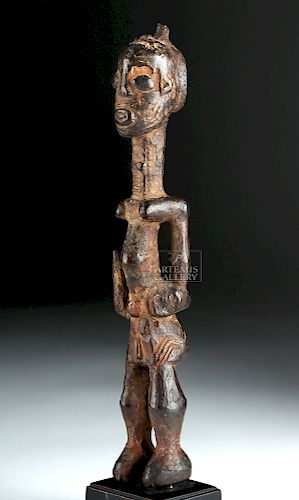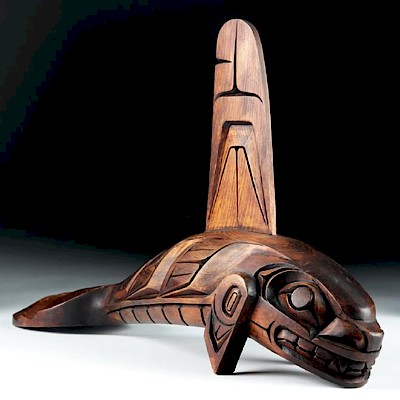Late 19th C. African Lulua Wood Mbulenga Female Figure
Lot 67a
About Seller
Artemis Gallery
686 S Taylor Ave, Ste 106
Louisville, CO 80027
United States
Selling antiquities, ancient and ethnographic art online since 1993, Artemis Gallery specializes in Classical Antiquities (Egyptian, Greek, Roman, Near Eastern), Asian, Pre-Columbian, African / Tribal / Oceanographic art. Our extensive inventory includes pottery, stone, metal, wood, glass and textil...Read more
Categories
Estimate:
$4,500 - $6,000
Absentee vs Live bid
Two ways to bid:
- Leave a max absentee bid and the platform will bid on your behalf up to your maximum bid during the live auction.
- Bid live during the auction and your bids will be submitted real-time to the auctioneer.
Bid Increments
| Price | Bid Increment |
|---|---|
| $0 | $25 |
| $300 | $50 |
| $1,000 | $100 |
| $2,000 | $250 |
| $5,000 | $500 |
| $10,000 | $1,000 |
| $20,000 | $2,500 |
| $50,000 | $5,000 |
| $100,000 | $10,000 |
| $200,000 | $20,000 |
About Auction
By Artemis Gallery
May 24, 2018
Set Reminder
2018-05-24 10:00:00
2018-05-24 10:00:00
America/New_York
Bidsquare
Bidsquare : Northwest Coast, Tribal, & Pre-Columbian Art
https://www.bidsquare.com/auctions/artemis-gallery/northwest-coast-tribal-pre-columbian-art-3238
Featuring Pacific Northwest Coast Native American Art from respected collector / dealer, Joseph Alphabet. Artemis Gallery info@artemisgallery.com
Featuring Pacific Northwest Coast Native American Art from respected collector / dealer, Joseph Alphabet. Artemis Gallery info@artemisgallery.com
- Lot Description
Central Africa, Democratic Republic of the Congo, Lulua (also Luluwa) peoples, ca. late 19th to early 20th century CE. A superb standing female figure, hand-carved from a single piece of hardwood, presenting exemplary form and meticulous detailing. The figure stands atop a pair of delineated legs which trace upwards to a bulbous posterior covered in serpentine scarification lines. Stable hips support a slender, slightly-distended abdomen, with perky breasts and rolled shoulders leading to angular arms, the right of which appears to be holding a club or staff. Her elongated neck boasts several incised rings and checkered designs, and a stylized head boasts bulging almond-shaped eyes, a petite nose, full lips, petite ears, and a knotted coiffure displayed above a concave verso. Shrouded in layers of lustrous espresso-hued patina and traces of natural red pigment from the camwood tree, this is a stellar example of Lulua craftsmanship! Custom wooden display stand included. Size: 10.25" H (26 cm); 11.25" H (28.6 cm) on included custom stand.
The people of the Lulua (Luluwa) tribe reside in the south-central region of the Democratic Republic of the Congo, set between lands occupied and controlled by the Chokwe, Kuba, and Luba tribes. Their location indicates that their specific form of artistic expression is widely-influenced by a plethora of different external factors. Carved wooden figures like this example are fine representations of how such cultural diversity influences one’s artistic creations and the meanings behind them. Wooden Lulua figures typically exhibit idealized aspects of what their culture defines as attractive, feminine, and desirable. Examples include the elongated necks, knotted coiffures, ample hips, and extensive facial and bodily scarification lines.
This type of figural carving, known as an "mbulenga," are often associated with facilitating the pregnancy process of as well as child birth. The name "mbulenga," which translates to "good luck and beauty," is evocative of the purpose of figures like this. Young expectant mothers would oftentimes carry these figures in their belts or beneath their gowns while they were pregnant as a spiritual means of protection. The Lulua believed that mbulenga figures embodied at least some aspect of spirits meant to protect pregnant women and ease the pains of pregnancy. Such spirits were thought to possess clairvoyant abilities, allowing diviners to study the aural appearance of the figure to foresee any potential complications the young mother-to-be may experience. Once the child is born, the mbulenga is placed near its bedside to protect it from harm or malevolent spiritual forces.
A similar example with more well-defined features hammered for $341,000 at Sotheby's, New York "In Pursuit of Beauty: The Myron Kunin Collection of African Art" Auction (sale N09225, November 11, 2014, lot 129): http://www.sothebys.com/en/auctions/ecatalogue/2014/myron-kunin-collection-african-art-n09225/lot.129.html
Provenance: private New York, New York, USA collection; ex-private von Ulrich von Schröder collection; ex-Harald Suhr collection
All items legal to buy/sell under U.S. Statute covering cultural patrimony Code 2600, CHAPTER 14, and are guaranteed to be as described or your money back.
A Certificate of Authenticity will accompany all winning bids.
We ship worldwide and handle all shipping in-house for your convenience.
#134091Area of coiffure, right arm, and left hand missing. Surface wear and abrasions commensurate with age as expected, fading to some carved details, with small nicks to feet, legs, arms, body, and head. A couple of stable hairline fissures and some encrustations. Great earthen deposits and beautiful dark-brown patina throughout.Condition
- Shipping Info
-
All shipping is handled in-house for your convenience. Your invoice from Artemis Gallery will include shipping calculation instructions. If in doubt, please inquire BEFORE bidding for estimated shipping costs for individual items.
-
- Buyer's Premium



 EUR
EUR CAD
CAD AUD
AUD GBP
GBP MXN
MXN HKD
HKD CNY
CNY MYR
MYR SEK
SEK SGD
SGD CHF
CHF THB
THB
















